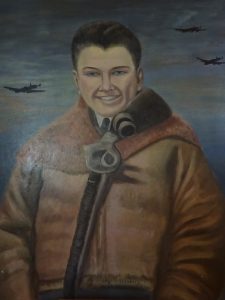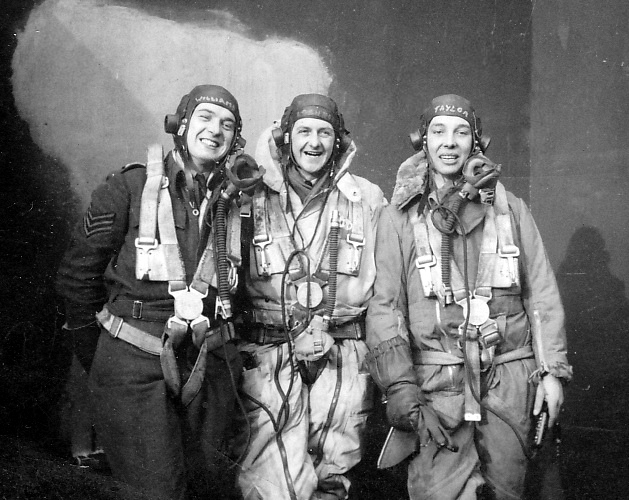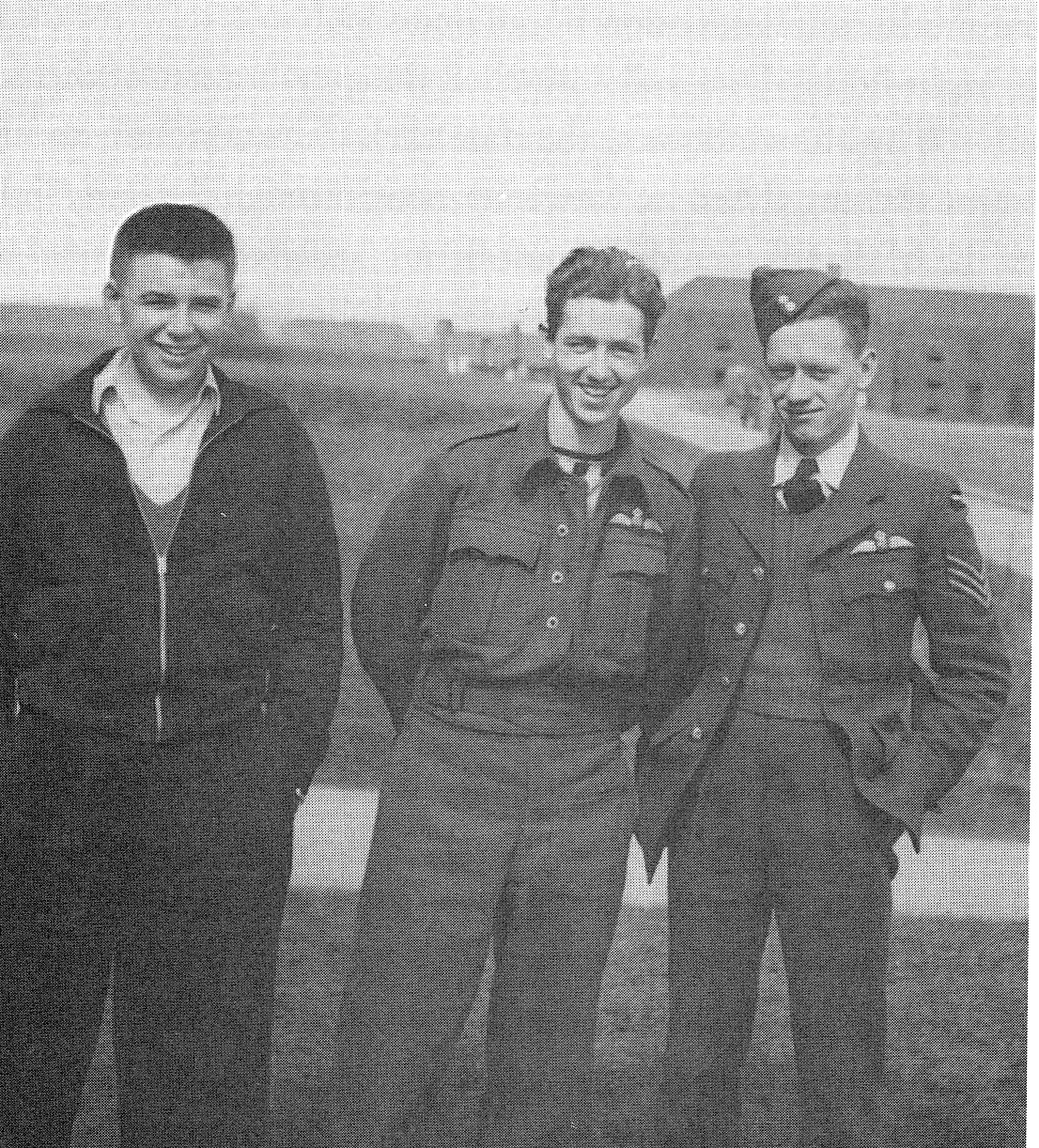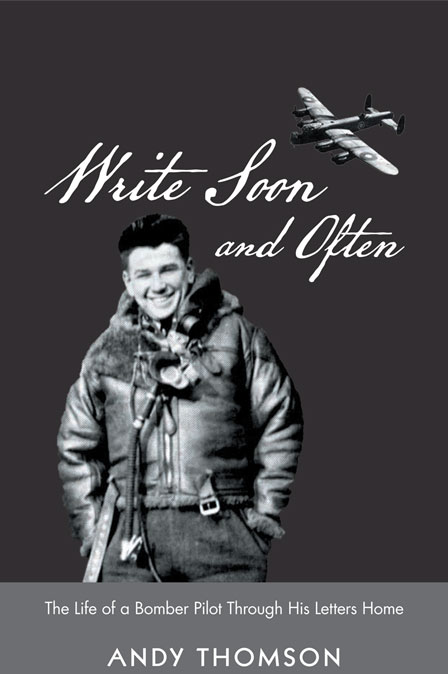Tribute to Donald’s Crew and Friends
His Crew
Donald’s crew became his ‘band of brothers,’ and through his letters he illustrated how much he enjoyed them. In a letter to his sister Jean, he wrote:
Right now, my tail gunner, Jock, is batting away at the piano and every now and again is playing ‘Yours’ which just about makes me weep. He was a pipe fitter and is quite a lot of fun and is half mad. But he is a good gunner and a nice chap. He is married and has a couple of children.
The rest of my crew (on the two-engine Manchester) is Canadian. My navigator is an ex-reporter and ex-officer of the Grenadier Guards of Montreal. My wireless operator is a Jewish kid from Hamilton. He made his living as a horn player in an orchestra. He has us all in stitches all the time. One big laugh. His latest is that if we get shot down over Germany, we tell Jerry his name is Paddy O’Brian so they won’t treat him too rough. My bomb aimer is a French Canadian and was a civil servant and he, too, is a fine chappie. My crew is as mad as they come, so I am happy. All the boys are older than I, and all engaged or married, so I had better be careful of them, or there will be a few people pretty peeved at me. They are all hair brained though and go around calling me “Skipper” whenever they see me within ten blocks. But from that, you can see the great melting pot this outfit is. OK, did I forget to tell you who the captain was?”
Donald Plaunt was one of seven crew members that was killed the night of March 12/13, 1943, when their Lancaster R5607X went down near Wulfen, Germany, just north of Essen. As the captain, he was in charge of the aircraft at all times, even if an officer of higher rank was on board. Each member had a different and important set of skills that contributed to the efficient and safe execution of the operation. A weak link could mean disaster for all.
Unfortunately, I don’t have much information about some of the crew, but hopefully if family members of these crewmen find this website, they will be able to contribute additional information.
For the complete description of Donald Plaunt’s Lancaster operations see: Flight Operations Carried Out by Sgt. D. C. Plaunt
After hearing that there was information about some of Donald’s crew I decided to add what I could find about each of them to this website.

A Lancaster bomber had a crew of seven. Donald was the pilot and the Captain. His crew: (back row) Joe Taylor, gunner; Trevor Williams, flight engineer; Jean-Louis Viau, bomb-aimer; (in front) Jock Lochrie, rear gunner, who was not on the fatal flight on March 12, 1943; and Ralph Frank, wireless operator. The 7th person, Alex Smith, the navigator, presumably took the photo.
The crew who were with my uncle the night of March 12/13 have an asterisk (*) beside their name.
CANADIAN
*Jean-Louis Viau, from Hull P. Q., Bomb Aimer
Canadian Virtual War Memorial (http://bit.ly/2yavY67) and Course 39,
No.4 Air Observer School, Crumlin, Ontario (http://bit.ly/2yaSGel) and http://bit.ly/2IE82KG
Ralph Frank, from Hamilton, ON, wireless operator
Canadian Virtual War Memorial (http://bit.ly/2wmntQU),
Find a Grave (http://bit.ly/2xJdXdV)
Tribute by Mark Howard for 97 Squadron (http://bit.ly/2UEK1ZG)
*Alex Smith, from West Summerland, B. C., navigator
Canadian Virtual War Memorial (http://bit.ly/2x03Z4h)
BRITISH
*William Cecil Burr, rear-gunner – only flew with Donald for one flight
*George William Dillon, wireless operator, replaced Ralph Frank on the last two flights
Jock Lochrie was the Scottish rear-gunner but was removed after 6 missions from Donald’s crew due to illness. He became disabled and spent the rest of his life in a veterans’ home. In a telegram to his mother Donald asked her to send a Christmas basket for Jock’s three-year old daughter. After my uncle’s death, his mother continued to sent gifts to the Lochrie family at Easter and Christmas, and after she died, my mother continued the tradition. My sister, Kathie, kept in touch with Jock’s wife until her death last year. I met with Jock a couple of times and I still remember my uncle’s words that he said to Jock: “If I make it to my 10th mission, I’ll be all right.” He was killed on his 11th! Jock pursued his interest in painting and send some of his paintings to my grandmother, including a portrait of the ‘Skipper.’

*Joe Taylor, mid-gunner,
*Trevor Williams, flight engineer

Trevor Williams, Jock Lochrie and Joe Taylor
His Sudbury Friends
Before Donald became attached to his bomber crew he was in contact with his many friends from his training days, his school and his two closest friends, Syd Smith and Billy Lane, from his home town of Sudbury, Ontario. He spent time visiting Syd and Bill on their bases, or taking leave together whenever their leaves coincided. Along with the letters from his family, it was these friendships that sustained his morale, as it did with other airmen, all so very young, and craving relationships with those they knew well. His two friends were also pilots: Syd of a Wellington, and Bill, a Spitfire. Syd was the only one that survived the war and near the end of his life published a book about his war experiences entitled: “Lifting the Silence.” Billy was killed almost one month after Donald and I have found some web pages that outline his time in his RCAF 403 Squadron.

Donald became friends with Billy Lane when they attended Central Public School in Sudbury. After Donald switched schools they later met up in Sudbury High School where they played football in their grade nine year. Syd attended SHS as well, but he got to know Donald earlier through the Copper Cliff Cadet Corps. The three buddies socialized together at the YMCA Saturday night dances under the directorship of Joe Barrett. Barrett would later meet them during the war as he managed a Y in London. Syd’s book described their friendship as the “Three Musketeers” and as a tribute and honour to his lost buddies, named two of his sons after them: Donald Cameron Smith and William Thompson Smith.
Bill flew a Spitfire pilot with RCAF 403 Squadron, and was killed on May 15, 1943 in a dog fight near Dieppe. He is buried in the Canadian War Cemetery. Syd piloted a Wellington bomber with RAF 115 Squadron but was shot down north-east of Paris. He was first hidden there, and then taken through the French underground from Paris to Gibraltar in time to be back in London for the final reunion of the Three Musketeers in February, 1943.
Bill Lane
RCAF Squadron 403 Tribute to P. O. William T. Lane Click below Lane’s photo for more information.
Squadron 403 History for May, 1943, see May 15
Sydney Smith
“Lifting The Silence” by Sydney Smith and David Smith, Dundurn Press, Toronto, 2010.



